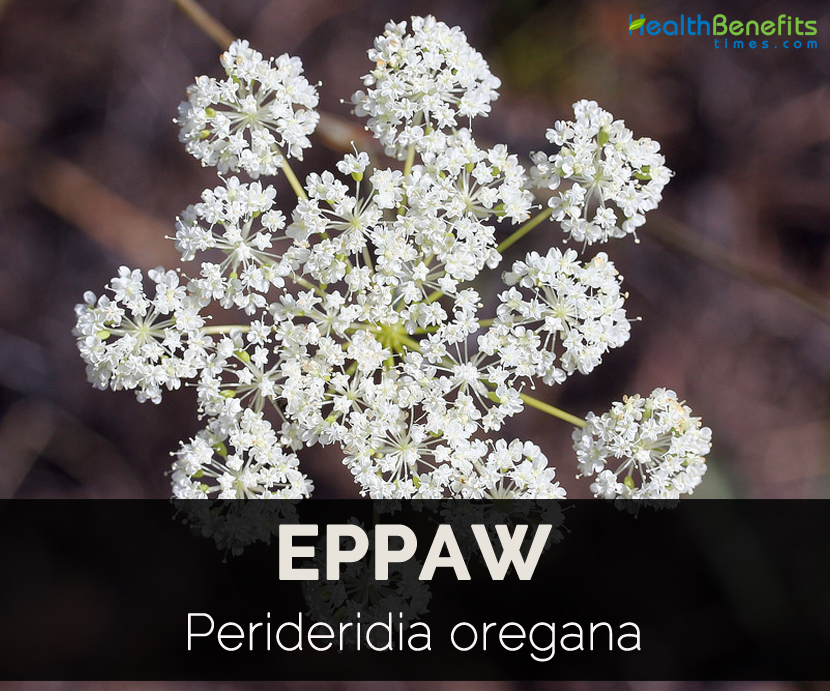 Perideria is a genus of plant in parsley family. The genus of this plant is known as yampa or yampah. Eppaw botanically known as Perideridia oregana, is a species of flowering plant belonging carrot family also known as Oregon yampah and squaw potato. It is inherent to California and Oregon in western United States where it is found in woodland or other habitat. The appearance of plant is variable. Generally, it is a perennial herb which grows about 10 to 90 centimeters tall and the green to waxy-grayish stem grows from a cluster of small tubers. Leaves near plant base have 3-30 centimeters long blades divided into various number of leaflets that are subdivided into smaller segments. An inflorescence is a compound umbel of various spherical clusters of white small flowers. Flowers are followed by ribbed and oblong shaped fruits measuring 3 to 6 millimeters long. It is common in Oregon, Northern California and Washington. This species have variable leaves usually resembling thread with little branching in leaflets.
Perideria is a genus of plant in parsley family. The genus of this plant is known as yampa or yampah. Eppaw botanically known as Perideridia oregana, is a species of flowering plant belonging carrot family also known as Oregon yampah and squaw potato. It is inherent to California and Oregon in western United States where it is found in woodland or other habitat. The appearance of plant is variable. Generally, it is a perennial herb which grows about 10 to 90 centimeters tall and the green to waxy-grayish stem grows from a cluster of small tubers. Leaves near plant base have 3-30 centimeters long blades divided into various number of leaflets that are subdivided into smaller segments. An inflorescence is a compound umbel of various spherical clusters of white small flowers. Flowers are followed by ribbed and oblong shaped fruits measuring 3 to 6 millimeters long. It is common in Oregon, Northern California and Washington. This species have variable leaves usually resembling thread with little branching in leaflets.
Description
Eppaw is a slender, perennial plant which grows 10 to 90 centimeters tall and is waxy to shining green. Plant arises from a cluster of two to six spindle shaped to spherical, chestnut-brown and tuberous roots. Basal leaf petiole is about ¾ to 4 inches (2-10 cm) long, sheathing throughout or to the middle. Leaves (basal) are triangular to ovate measuring 1 ½ to 5 ½ in. (4-14 cm) broad and 1 to 12 in. (3-30 cm) long. Leaves are pinnately dissected having leaflets further dissected into three narrow segments. Ultimate segments are ¼ in. (0.5-6 mm) broad and 3/16 to 2 3/8 in. (0.5-6 cm) long. The plant has 1-29 unequal rays of flower clusters measuring 1 to 1 ½ in (2.5-4 cm) long. The clusters of flower contain 10 to 29 flowers having toothed leafy bracts beneath. Petals are white, rounded, about 1/16 inches (1 to 1.5 mm) long and broad with a single vein. Fruit is oblong measuring 1/16 in. (1.5-2 mm) broad, 1/8 to ¼ in. (3-6 mm) long with threadlike ribs.
Habitat
Perideridia oregano is found in prairies, oak woodlands, moist or dry meadows and is found at an elevation of 380 feet (100 meters) in Washington.
How to eat
- Roots are dried for later use.
- Consume the roots raw or cooked.
- It could be fried, boiled or roasted.
References:
https://www.itis.gov/servlet/SingleRpt/SingleRpt?search_topic=TSN&search_value=29811#null
https://pfaf.org/user/Plant.aspx?LatinName=Perideridia+oregana
https://www.cultivariable.com/instructions/root-crops/how-to-grow-yampah/
https://www.dnr.wa.gov/publications/amp_nh_perore.pdf

